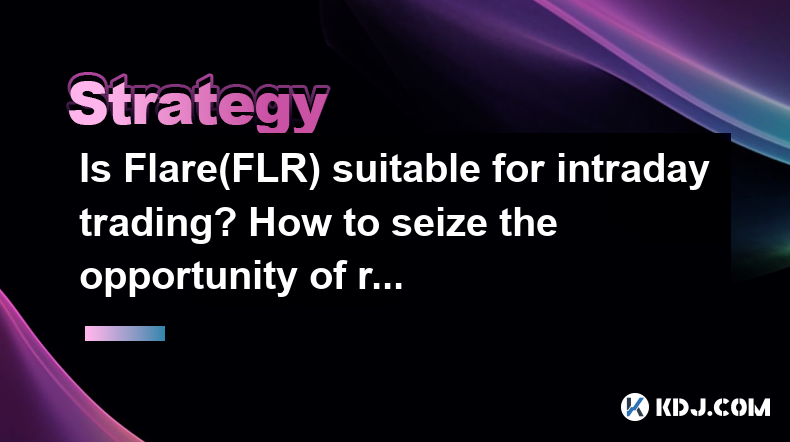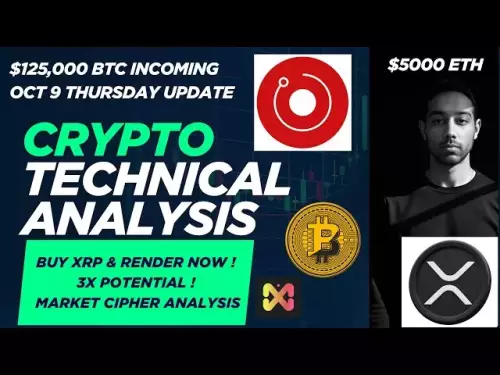-
 bitcoin
bitcoin $122659.385674 USD
0.52% -
 ethereum
ethereum $4484.113342 USD
-0.09% -
 bnb
bnb $1304.229256 USD
-0.85% -
 tether
tether $1.000204 USD
-0.03% -
 xrp
xrp $2.860636 USD
-0.51% -
 solana
solana $227.288799 USD
2.36% -
 usd-coin
usd-coin $0.999805 USD
0.01% -
 dogecoin
dogecoin $0.252837 USD
1.18% -
 tron
tron $0.341149 USD
1.12% -
 cardano
cardano $0.830507 USD
0.33% -
 hyperliquid
hyperliquid $45.792319 USD
0.04% -
 chainlink
chainlink $22.422164 USD
1.55% -
 ethena-usde
ethena-usde $1.000283 USD
0.01% -
 sui
sui $3.511389 USD
0.83% -
 stellar
stellar $0.385276 USD
-0.44%
Is Flare(FLR) suitable for intraday trading? How to seize the opportunity of rapid fluctuations?
FLR's rapid price fluctuations make it suitable for intraday trading; use technical analysis and stay updated on news to seize opportunities.
May 05, 2025 at 05:56 am

Is Flare (FLR) suitable for intraday trading? How to seize the opportunity of rapid fluctuations?
Intraday trading, also known as day trading, involves buying and selling a cryptocurrency within the same trading day to capitalize on short-term price movements. Flare (FLR), a relatively new player in the cryptocurrency market, has garnered attention for its unique features and potential for rapid price fluctuations. This article explores whether FLR is suitable for intraday trading and provides detailed guidance on how to seize opportunities arising from its rapid price movements.
Understanding Flare (FLR) and Its Market Dynamics
Flare (FLR) is a blockchain platform designed to enhance the interoperability of decentralized applications (dApps) and smart contracts across multiple networks. It aims to provide developers with access to data from other blockchains, making it a versatile and potentially lucrative asset for traders. The market dynamics of FLR are influenced by several factors, including technological developments, partnerships, and broader market sentiment towards interoperability solutions.
The price of FLR can experience significant fluctuations due to its relatively low market capitalization and the speculative nature of the cryptocurrency market. These rapid price movements make FLR an attractive candidate for intraday trading, as traders can potentially profit from short-term price swings.
Assessing FLR's Suitability for Intraday Trading
When evaluating FLR's suitability for intraday trading, several key factors need to be considered. First, the liquidity of FLR is crucial. Higher liquidity means that traders can enter and exit positions more easily, which is essential for day trading. FLR's liquidity can vary, and traders should monitor trading volumes to ensure they can execute trades efficiently.
Second, volatility is a double-edged sword in intraday trading. While high volatility can lead to significant profits, it also increases the risk of substantial losses. FLR has shown periods of high volatility, which can be advantageous for experienced traders who can manage risk effectively.
Lastly, market sentiment and news related to FLR can significantly impact its price. Traders need to stay informed about developments within the Flare ecosystem, such as new partnerships, technological upgrades, or regulatory changes, as these can create trading opportunities.
Strategies for Seizing Opportunities in FLR Intraday Trading
To successfully seize opportunities in FLR intraday trading, traders can employ various strategies tailored to the cryptocurrency's unique characteristics. Here are some effective approaches:
Technical Analysis: Utilize technical indicators such as moving averages, Relative Strength Index (RSI), and Bollinger Bands to identify potential entry and exit points. For instance, a crossover of the short-term moving average above the long-term moving average may signal a buying opportunity, while an RSI above 70 could indicate an overbought condition, suggesting a potential sell.
Scalping: This strategy involves making numerous small trades throughout the day to profit from minor price movements. Given FLR's potential for rapid fluctuations, scalping can be particularly effective. Traders should set tight stop-loss orders to manage risk and aim for small, consistent profits.
Breakout Trading: Identify key support and resistance levels on FLR's price chart. A breakout above resistance or below support can signal a strong move in the direction of the breakout. Traders can enter positions following a confirmed breakout and use trailing stop-loss orders to protect profits.
News Trading: Stay updated with news and announcements related to Flare. Positive news, such as new partnerships or technological advancements, can lead to rapid price increases, while negative news can cause sharp declines. Traders can capitalize on these events by entering positions before the news becomes widely known and exiting once the price movement stabilizes.
Tools and Resources for FLR Intraday Trading
To effectively engage in FLR intraday trading, traders need access to reliable tools and resources. Here are some essential components:
Trading Platform: Choose a reputable cryptocurrency exchange that offers FLR trading pairs with sufficient liquidity. Popular platforms include Binance, KuCoin, and Coinbase. Ensure the platform provides real-time data, advanced charting tools, and the ability to set stop-loss and take-profit orders.
Charting Software: Use advanced charting software like TradingView or MetaTrader to analyze FLR's price movements. These tools offer a wide range of technical indicators and drawing tools to help traders make informed decisions.
News Aggregators: Subscribe to cryptocurrency news aggregators such as CoinDesk, CryptoSlate, or CoinTelegraph to stay informed about developments related to Flare. Set up alerts for FLR-specific news to react quickly to market-moving events.
Risk Management Tools: Implement risk management tools such as stop-loss orders, position sizing calculators, and risk-reward ratio assessments to protect your trading capital. These tools help mitigate the impact of adverse price movements and ensure long-term sustainability.
Executing FLR Intraday Trades: A Step-by-Step Guide
To execute FLR intraday trades effectively, follow these detailed steps:
Research and Analysis: Begin by conducting thorough research on FLR's recent price movements, market sentiment, and upcoming events. Use technical analysis to identify potential entry and exit points based on your chosen strategy.
Set Up Your Trading Platform: Log into your chosen trading platform and navigate to the FLR trading pair. Ensure you have sufficient funds in your account to cover your intended trade size.
Place Your Trade:
- If using a market order, click on the 'Buy' or 'Sell' button to execute the trade at the current market price.
- If using a limit order, specify the price at which you want to buy or sell FLR. The order will be executed once the market reaches your specified price.
Set Risk Management Parameters: Immediately after placing your trade, set a stop-loss order to limit potential losses. Consider setting a take-profit order to secure profits at a predetermined level.
Monitor and Adjust: Continuously monitor FLR's price movements and market news. Be prepared to adjust your stop-loss and take-profit orders based on new information or changes in market conditions.
Close Your Position: Once your trade reaches your target profit or hits your stop-loss, close the position to realize your gains or limit your losses. Review your trade to learn from the experience and refine your strategy for future trades.
Frequently Asked Questions
Q: How can I determine the best time to trade FLR intraday?A: The best time to trade FLR intraday can vary based on market conditions and your trading strategy. Generally, trading during periods of high liquidity, such as when major cryptocurrency markets are open (e.g., during Asian, European, and North American trading sessions), can provide better opportunities. Additionally, monitoring FLR's price volatility and trading volume can help identify optimal trading times.
Q: What are the common pitfalls to avoid when trading FLR intraday?A: Common pitfalls include overtrading, neglecting risk management, and reacting emotionally to price movements. Traders should avoid chasing losses, trading without a clear strategy, and failing to set stop-loss orders. It's also important to maintain discipline and stick to your trading plan.
Q: Can I use automated trading bots for FLR intraday trading?A: Yes, automated trading bots can be used for FLR intraday trading. These bots can execute trades based on predefined criteria and technical indicators, potentially increasing efficiency and reducing emotional decision-making. However, traders should thoroughly test and monitor their bots to ensure they perform as expected and adjust settings as needed.
Q: How important is it to stay updated with FLR's ecosystem developments for intraday trading?A: Staying updated with FLR's ecosystem developments is crucial for intraday trading. News and announcements can significantly impact FLR's price, creating trading opportunities. Traders should use news aggregators and set up alerts to react quickly to market-moving events and adjust their trading strategies accordingly.
Disclaimer:info@kdj.com
The information provided is not trading advice. kdj.com does not assume any responsibility for any investments made based on the information provided in this article. Cryptocurrencies are highly volatile and it is highly recommended that you invest with caution after thorough research!
If you believe that the content used on this website infringes your copyright, please contact us immediately (info@kdj.com) and we will delete it promptly.
- US Treasury, Bitcoin, and Reserve Expansion: A New Era?
- 2025-10-10 02:45:12
- Trading Bots & AI Algorithms: Your 2025 Edge
- 2025-10-10 02:45:12
- Monero and Zcash: Privacy Coins Spark Price Breakout
- 2025-10-10 02:45:38
- Zora Crypto Price Jumps After Robinhood Listing: A New York Minute on the Altcoin Scene
- 2025-10-10 02:25:16
- Digital Gold: Future of Ownership and Investment in the Crypto Age
- 2025-10-10 02:45:38
- BlockDAG, Formula 1, and Crypto Investing: A Winning Combination for Mainstream Adoption
- 2025-10-10 03:05:16
Related knowledge

Practical parameter settings for a Bitcoin multi-timeframe moving average system
Sep 18,2025 at 10:54pm
Optimizing Timeframe Combinations for Bitcoin Trading1. Selecting appropriate timeframes is crucial when building a multi-timeframe moving average sys...

How can I filter out false breakouts in Dogecoin high-frequency trading?
Sep 22,2025 at 01:00am
Understanding False Breakouts in Dogecoin Trading1. A false breakout occurs when Dogecoin's price appears to move beyond a defined support or resistan...

Techniques for identifying tops and bottoms in the Bitcoin on-chain NVT model
Sep 20,2025 at 07:54pm
Understanding the NVT Model in Bitcoin Analysis1. The Network Value to Transactions (NVT) ratio is often described as the 'P/E ratio' of the cryptocur...

What does the surge in open interest in Bitcoincoin futures mean?
Sep 20,2025 at 11:18pm
Understanding the Surge in Dogecoin Futures Open Interest1. A surge in open interest within Dogecoin futures indicates a growing number of active cont...

How can I use the Ethereum USDT premium to gauge market sentiment?
Sep 18,2025 at 11:55pm
Understanding the Ethereum USDT Premium1. The Ethereum USDT premium refers to the price difference between USDT (Tether) traded on Ethereum-based plat...

What should I do if Ethereum staking yields decline?
Sep 20,2025 at 06:18am
Understanding the Causes Behind Declining Ethereum Staking Yields1. The Ethereum network transitioned to a proof-of-stake consensus mechanism with the...

Practical parameter settings for a Bitcoin multi-timeframe moving average system
Sep 18,2025 at 10:54pm
Optimizing Timeframe Combinations for Bitcoin Trading1. Selecting appropriate timeframes is crucial when building a multi-timeframe moving average sys...

How can I filter out false breakouts in Dogecoin high-frequency trading?
Sep 22,2025 at 01:00am
Understanding False Breakouts in Dogecoin Trading1. A false breakout occurs when Dogecoin's price appears to move beyond a defined support or resistan...

Techniques for identifying tops and bottoms in the Bitcoin on-chain NVT model
Sep 20,2025 at 07:54pm
Understanding the NVT Model in Bitcoin Analysis1. The Network Value to Transactions (NVT) ratio is often described as the 'P/E ratio' of the cryptocur...

What does the surge in open interest in Bitcoincoin futures mean?
Sep 20,2025 at 11:18pm
Understanding the Surge in Dogecoin Futures Open Interest1. A surge in open interest within Dogecoin futures indicates a growing number of active cont...

How can I use the Ethereum USDT premium to gauge market sentiment?
Sep 18,2025 at 11:55pm
Understanding the Ethereum USDT Premium1. The Ethereum USDT premium refers to the price difference between USDT (Tether) traded on Ethereum-based plat...

What should I do if Ethereum staking yields decline?
Sep 20,2025 at 06:18am
Understanding the Causes Behind Declining Ethereum Staking Yields1. The Ethereum network transitioned to a proof-of-stake consensus mechanism with the...
See all articles


























![🚨IS VECHAIN (VET) A DEAD COIN ?? PRICE ANALYSIS [GET READY NOW] 🚨IS VECHAIN (VET) A DEAD COIN ?? PRICE ANALYSIS [GET READY NOW]](/uploads/2025/10/09/cryptocurrencies-news/videos/vechain-vet-dead-coin-price-analysis-ready/68e7b200b067b_image_500_375.webp)















































